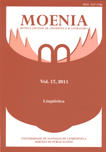Caroline Myrick & Walt Wolfram (eds.): The 5 Minute Linguist. Bite-Sized Essays on Language and Languages, 3rd ed. Sheffield: Equinox Publishing, 2019, XVI + 345pp. ISBN: 978-178-179-855-3
Contenido principal del artículo
Detalles del artículo
Referencias
Bauer, L. & P. Trudgill (eds.) (1998): Language myths. London: Penguin.
Bauer, L. & P. Trudgill (1998): “Introduction”. En L. Bauer & P. Trudgill (eds.): Language Myths. London: Penguin, XV-XVIII.
Dueñas González, R. & I. Melis (eds.) (2000): Language ideologies. Critical perspectives on the Official English Movement. Vol. 1: Education and the social implications of official language. Urbana, IL & Mahwah, NJ: National Council of Teachers of English & Lawrence Erlbaum.
Dueñas González, R. & I. Melis (eds.) (2001): Language ideologies. Critical perspectives on the Official English Movement. Vol. 2: History, Theory, and Policy. Urbana, IL & Mahwah, NJ: National Council of Teachers of English & Lawrence Erlbaum.
Fitch, W. T. (2000): “The phonetic potential of nonhuman vocal tracts: Comparative cineradiographic observations of vocalizing animals”. Phonetica 57: 205-18.
Fitch, W. T. (2017): “Empirical approaches to the study of language evolution”. Psychonomic Bulletin & Review 24: 3-33.
Fitch, W. T. & D. Reby (2001): “The descended larynx is not uniquely human”. Proceedings of the Royal Society of London B 268: 1669-75.
Hauser, M. D. & W. T. Fitch (2003): “What are the uniquely human components of the language faculty?”. En M. Christiansen & S. Kirby (eds.): Language evolution. New York: Oxford University Press, 158-81.
Lieberman, P. (1984): The biology and evolution of language. Cambridge, MA: Harvard University Press.
Lieberman, P. (2003): “Motor control, speech, and the evolution of human language”. En M. Christiansen & S. Kirby (eds.): Language evolution. New York: Oxford University Press, 255-71.
Lieberman, P., D. H. Klatt & W. H. Wilson (1969): “Vocal tract limitations on the vowel repertoires of rhesus monkey and other nonhuman primates”. Science 164: 1185-87.
Macedo, D. (2000): “The colonialism of the English Only Movement”. Educational Researcher 29/3: 15-24.
McDougall, I., F. H. Brown & J. G. Fleagle (2005): “Stratigraphic placement and age of modern humans from Kibish, Ethiopia”. Nature 433: 733-6.
McDougall, I., F. H. Brown & J. G. Fleagle (2008): “Sapropels and the age of hominins Omo I and Omo II, Kibish, Ethiopia”. Journal of Human Evolution 55: 409-20.
Negus, V. E. (1949): The comparative anatomy and physiology of the larynx. New York: Hafner.
Nishimura, T., A. Mikami, J. Suzuki & T. Matsuzawa (2006): “Descent of the hyoid in chimpanzees: Evolution of face flattening and speech”. Journal of Human Evolution 51: 244-54.
Pearson, O. M. (2013): “Africa: The cradle of modern people”. En F. H. Smith & J. C. M. Ahern (eds.): The origins of modern humans. Biology reconsidered. Hoboken, NJ: John Wiley & Sons, 1-43.
Relethford, J. H. (2008): “Genetic evidence and the modern human origins debate”. Heredity 100/6: 555-63.
Stringer, C. & J. Galway-Witham (2017): “On the origin of our species”. Nature 546: 212-4.
Tattersall, I. (2009): “Human origins: Out of Africa”. Proceedings of the National Academy of Sciences USA 106/38: 16018-21.
Weissengruber, G. E., G. Forstenpointner, G. Peters, A. Kübber-Heiss & W. T. Fitch (2002): “Hyoid apparatus and pharynx in the lion (Panthera leo), jaguar (Panthera onca), tiger (Panthera tigris), cheetah (Acinonyx jubatus), and domestic cat (Felis silvestris f. catus)”. Journal of Anatomy 201: 195-209.
White, T. D., B. Asfaw, D. DeGusta, H. Gilbert, G. D. Richards, G. Suwa & F. C. Howell (2003): “Pleistocene Homo sapiens from Middle Awash, Ethiopia”. Nature 423: 742-7.
Artículos más leídos del mismo autor/a(s)
- Antonio Benítez-Burraco, Víctor M. Longa, Los peligros de la interpretación de las evidencias indirectas sobre la evolución del lenguaje: dextralidad y capacidad lingüística de los Neandertales , Moenia: Vol. 17 (2011)
- Victor M. Longa, J.J. López Rivera, Bibliografía seleccionada y comentada sobre la metáfora , Moenia: Vol. 17 (2011)
- Víctor M. Longa, Cuando el traductor es demasiado visible: reescritura y manipulación en la traducción del título de un libro , Verba: Anuario Galego de Filoloxía: Vol. 39 (2012)
- Victor M. Longa, Reseña de Robert C. Berwick y Noam Chomsky (2016): Why only us. Language and evolution. Cambridge, MA: The MIT Press, viii + 215 pp. , Verba: Anuario Galego de Filoloxía: Vol. 44 (2017)
- Victor M. Longa, Dixon, R. M. W. (2016): Are some languages better than others? New York: Oxford University Press, vii + 272 págs. , Verba: Anuario Galego de Filoloxía: Vol. 47 (2020)







